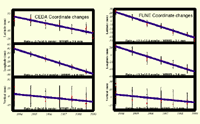Reconciling disparate estimates for slip rate on the Owens Valley fault, California
 |
M. Meghan Miller1, Jeffrey Lee1, and Timothy H. Dixon2 |
Abstract
The Owens Valley fault partitions dextral slip related to the northward penetration of the Eastern California shear zone. Recent geologic and geodetic studies yield conflicting fault slip rate estimates. Holocene vertical offset along the subsidary Lone Pine rupture and a characteristic ratio of vertical to horizontal slip during the 1872 event indicate a maximum dextral slip rate of 2±1 mm/year [Beanland and Clark, 1994]. Only three large Holocene earthquakes, including the 1872 Owens Valley earthquake, are recognized. Paleoseismic studies south of Big Pine [J. Lee, unpublished data] corroborate low slip rates of 1.7±1.0 mm/year and a recurrence interval between 3300±600 to 4000±400 years. Geodetic rates are greater by a factor of three [Miller et al., 2000; Savage and Lisowski, 1995] and apparently imply that Holocene surface ruptures along the Lone Pine trace alone cannot account for the total Holocene offset.
A slip rate of 7 mm/year implies recharge time for a 1872 event, with a coseismic dextral offset of 4-6 meters, 570 to 860 years; requiring a dozen or more large Holocene events. Only three are recognized. It is unlikely that evidence for such Holocene offsets could be overlooked, even on strands of the fault which did not rupture in 1872.
Part of the discrepancy between geodetic and geologic rates may reflect the viscoelastic nature of the lower crust and influence of earthquake cycle effects, specifically the 1872 Owens Valley event. In order to evaluate these effects we assess the GPS results along two transects, one just south of Lone Pine, Ca and one near the Tinnemaha Reservoir. First, we correct for the elastic strain contribution to GPS station velocities from nearby or major faults. Then, we assess the remaining velocity field through a series of viscoelastic models that take into account the recency of the 1872 Owens Valley earthquake and recurrence interval.
1Department of Geological Sciences, Central Washington University, Ellensburg, Washington
2 Rosentiel School of Marine and Atmospheric Sciences, University of Miami, Miami, FL 33149
|
|
GSA 2000 poster (8.9 MB) |